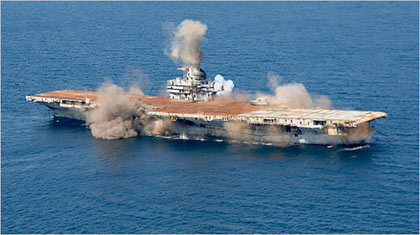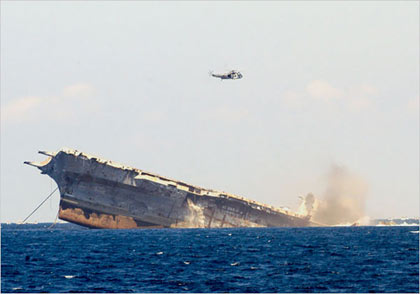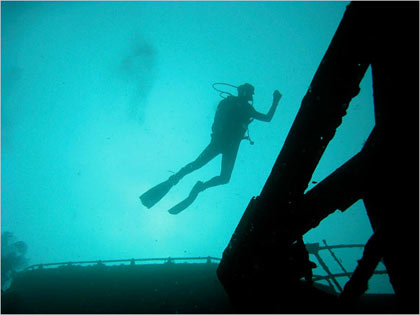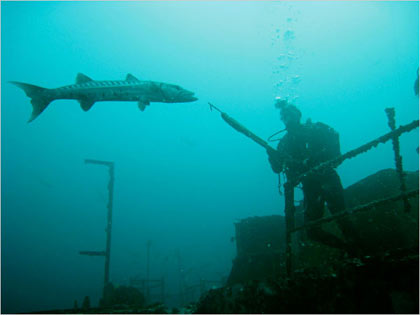You are hereBlogs / WcP.Story.Teller's blog / Warship now a home for fish: U.S.S. Oriskany, The Great Carrier Reef, is largest vessel ever sunk to make a reef
Warship now a home for fish: U.S.S. Oriskany, The Great Carrier Reef, is largest vessel ever sunk to make a reef

(quote)
PENSACOLA, Fla. - For Thom Dietmeyer, a retired naval officer, standing again on the bridge of his old ship was a dream come true, even if he was 70 feet below the surface of the ocean. “I knew exactly where I was going as soon as I got down there,” he said, recalling the dive, which took place a year ago last May on the wreck of an aircraft carrier called the Oriskany. The U.S.S. Oriskany, known as the Mighty-O, was commissioned in 1950 and served in Korea and Vietnam. The ship was sunk by the Navy in May 2006 under a pilot program to convert decommissioned vessels into artificial reefs. At 44,000 tons, 888-foot-long, it is by far the largest vessel ever sunk to make a reef.

Over the years, proposals to recom- mission the ship, to refurbish it as a museum and to scrap it all failed to be carried out. In 2004, the United States Navy announced that the ship would be sunk in the Gulf of Mexico off Florida to become an artificial reef. On May 17, 2006, the U.S.S. Oriskany was towed about 24 miles south of Pensacola, where 500 pounds of strategically placed explosive charges scuttled it. Within 45 minutes -- four hours faster than anticipated -- the Oriskany slipped below the surface and sank 210 feet to the sea floor. When it hit the bottom, ownership of the ship, passed from the Navy to the state of Florida.
"The Great Carrier Reef" has become a popular diving spot, with more than 4,200 visits in 2007. The Oriskany is by far the largest ship ever to be intentionally sunk as an artificial reef. The Oriskany's primary flight control tower, where the "air boss" directed takeoffs and landings on the ship's 162-foot wide flight deck, was seen in movies like "The Bridges of Toko-Ri" and "The Men of the Fighting Lady" starring Van Johnson.

The Navy currently holds 59 ships in inactive status, a number it hopes to reduce by as many as 20 over the next decade. Most will be dismantled and turned into scrap, but several will most likely become artificial reefs along the nation’s coastline, and the response to the Oriskany, the Navy says, has been encouraging. “There’s definitely an enthusiasm for this,” said Glen Clark of the Navy’s Inactive Ships Program. “There’s actually more interest than we have ships.”
The potential economic benefits of sinking ships for reefs are significant. A report from the University of West Florida says that the sinking of the Oriskany generated nearly $4 million for Pensacola and Escambia County in 2007. But making reefs of Navy ships comes with serious environmental challenges. The Navy spent $20 million to clean the Oriskany, but left an estimated 700 pounds of polychlorinated biphenyls, or PCBs, on the ship, mainly in wiring and bulkhead insulation.

Some ecologists warned that the sinking of the Oriskany would unne- cessarily risk introducing PCBs into the food chain. The Navy worked with the Environmental Protection Agency to create special guidelines allowing the PCBs to stay, and a State of Florida study is under way to determine whether the chemicals are entering the environment. Meanwhile, the wreck is being dived and fished nearly every day. Seventy feet down, the Oriskany’s navigation tower is teeming with prickly sea urchins and crusty barnacles. Giant barracuda prowl the tower’s empty windows. The wreck has attracted at least 38 species of fish, including goliath groupers, mako sharks, amberjacks and red snappers. While the Navy spent $20 million cleaning the ship before sinking it, nearly 700 pounds of PCBs were left aboard, mostly in wiring and insulation. Florida is monitoring whether the PCBs are entering the food chain.

With the Navy seeking to reduce its number of inactive ships from 59 to about 20, more former warships may be turned into coral reefs. The next ship likely to be transformed is the U.S.S. Arthur W. Radford, a 562-foot destroyer. Delaware, New Jersey and Pennsylvania have collectively proposed turning the Radford into the largest artificial reef project on the East Coast.
(unquote)
Photos courtesy of United States Navy / Megan Kohr, Agence France-Presse and Getty Images, Art Giberson/Associated Press, and Erik Olsen
Original Source: NY Times
Related Link: Scuba Forum


















